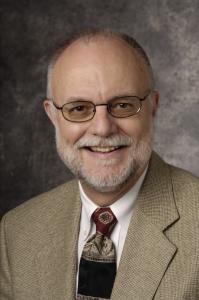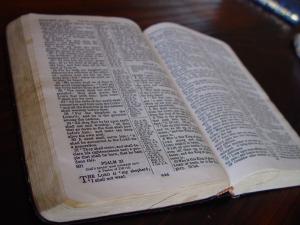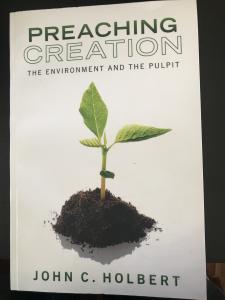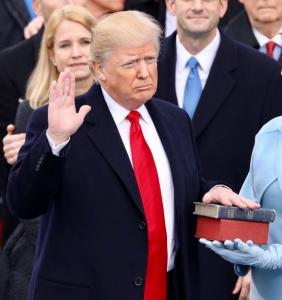 “Congress shall make no law respecting an establishment of religion, or prohibiting the free exercise thereof; or abridging the freedom of speech, or of the press; or the right of the people peaceably to assemble, and to petition the government for a redress of grievances.”
“Congress shall make no law respecting an establishment of religion, or prohibiting the free exercise thereof; or abridging the freedom of speech, or of the press; or the right of the people peaceably to assemble, and to petition the government for a redress of grievances.”
Well, there is the First Amendment to the Constitution of the USA. It is a grand statement, but has been fraught over its 240 or so years with any number of interpretations, broad and narrow, self- serving and community-concerned, wise and ridiculous. It may be important to note that it is only the second branch of government, the Congress, that is specifically addressed, suggesting that only in that deliberative body may laws be “established,” that is suggested and passed. But, of course, the amendment has more recently been referred to in vast numbers of societal struggles, far beyond the “original intent” (Oh fractious words!) of the framers.
It is always important to remember the historical context out of which these words were composed. The Continental Congress in the last quarter of the 18th century was peopled by colonists who were the heirs of the first white settlers of the country to be. Those “Puritans” (I place the word in quotations since not all would have so described themselves) were in the main fleeing from an England that had witnessed lengthy struggles with religious intolerance, the country swinging back and forth between Protestant and Catholic, depending on the monarch, since the reign of Henry VIII’s turn to the former in the attempt to find a woman to give him a male heir. Ironically, his first wife, the staunchly Catholic Catherine, and Henry’s sister-in-law, failed at the task, though did provide a female heir, Mary, who would cause no end of difficulty through the subsequent reign of Elizabeth I, daughter of Anne Boleyn, Henry’s second wife, and perhaps the most significant monarch in the country’s history. Along the way, any number of persons who were either Catholic or Protestant, found themselves on the wrong side of the religious divide and suffered imprisonments or gruesome deaths. The writers of the First Amendment, wanting nothing of that, strictly forbid any Congress from “establishing any religion” above any other religion, but at the same time “prohibiting the free exercise” of any religion whatever, an openness that has long served the religious community very well.
Last Monday, President Donald Trump singlehandedly and highhandedly, tried to shatter the First Amendment to the Constitution of the USA, a Constitution he had sworn in 2016 “to preserve, protect, and defend.” After a press conference, or a public announcement—it was hard to tell what he had in mind exactly—where he proclaimed himself “a law and order president,” and where he vowed to use the full force of the military of the US to quell the peaceful protests and minority rioting occurring in many large cities, if the governors of the states where the protests were occurring did not, as he indelicately put it “dominate” the streets of those cities, he then demanded—at the apparent direction of his sycophantic Attorney General, Bill Barr– that the streets around the White House be cleared by the large police force and National Guard assembled, so that he might stroll to the historic St. James Episcopal Church across the street, and there engage in one of the more absurdly memorable photo ops in recent memory.
Many former presidents have worshipped in this church over the years, though Trump has rarely worshipped anywhere, preferring the golf course to the pew on most free Sundays, thereby identifying with a large number of his fellow Americans, it must be said, but not mirroring many of his most ardent followers who do in fact eschew the links for the church on most Sundays. A rich irony to be sure! St. James had been slightly burned the previous day by some rioters, and there the president stood, in front of a sign saying that “all are welcome,” while he raised a Bible in the air, making the sacred book appear to be rather like a ping pong paddle or a dark weapon of some kind. When asked by a reporter whether the Bible was his, he responded, “It is a Bible,” a curious reply, but clearly a truthful one.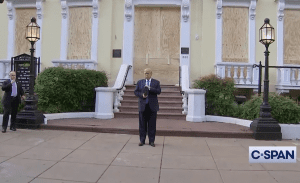
Exactly why this photograph was so staged has been the source of much talk, some witty and some serious. I choose to see the humor in it, no doubt unintended by the President, along with the deadly serious claims that he was attempting to make. It is more than obvious what that Bible meant to him; it was the talisman (a designation I coined in an earlier essay) supportive of the language he had just used in the Rose Garden at the White House. That Bible meant for Donald Trump the authority and power to do exactly what he had just done by clearing the streets of peaceful protesters through the use of flash grenades and clubs and shields, and what he proposed to do by the imposition of the US military against the citizens of the country. For him, it was the Bible, the ancient book of Christians and Jews, that gave him, in his own mind, the right and the duty to act in the ways he had acted and had determined to act. In short, the Bible in his upraised hand had become the very symbol of the crushing of the First Amendment to the Constitution, the idea that the President of the USA has the right to quell any and all dissent, any and all protest, any and all freedom of “speech, press, and the right to peacefully assemble.” Only power, only dominance, approved by the talisman of the Bible, could “make America great again.”
Perhaps if Donald Trump had opened that Bible, and had read a page or two in it, he might have discovered that his talismanic application of the book could be seen to founder on the strength of its actual words. For example, a quick perusal of that 2700-year old Amos 7 would have suggested that the attempt of the High Priest of Israel, Amaziah by name, to throw the prophet Amos out of the temple by saying that the temple was in reality “the king’s sanctuary, the temple of the kingdom,” and not actually the temple of God, could have taught the president that the ethical authority of the prophet of God calls into serious question the power of any and all earthly authority. Or he might have turned to 2 Samuel 12, where he would read that the mighty King David, after breaking four of the ten commandments in 2 Kings 11, was confronted by another prophet, Nathan this time, who tells him a little tale of oppression, and then fingers the king with a withering, “You are the man!” It turns out that the King of Israel is not free in the sight of God to do as he pleases after all.
Any number of passages in the New Testament could have given the president pause in his rush to “dominate” the streets. “Those who live by the sword, die by the sword,” warns Jesus; “do any of you condemn this woman,” says Jesus to the crowd thirsting for revenge against a woman caught in adultery; after a painful silence, Jesus says, “Neither do I.” Or this famous scene might have cooled the president’s own passion for war. Jesus hangs on that Roman cross, and forgives his killers; Jesus never seeks to “dominate the streets;” he seeks ways to bring all into the realm and rule of his God. That is why the sign in front of St. James Church says, “All are welcome,” not only those who agree with the president, not only those who believe in a certain way, not only those who toe one political line or another, not only those who are silent in the face of oppression or those who protest loudly against it. All means all. Black Lives Matter. Systematic racism is evil and must be confronted, and the First Amendment affirms the right of all to protest and to seek redress for their long- suffered oppressions.
Holding up that Bible in front of a church makes Donald Trump neither a defender of safety nor a champion of the oppressed. It makes him a stark danger to the basic prerogatives of our republic, enshrined in that magnificent First Amendment. Do not be fooled by his so-called Bible-anointed power play. He was in fact blaspheming the sacred book, and though his blind followers may find his very grasping of the book a sign of his religiousness, a sign that he intends to defend them and the Christian life, they are quite wrong. They have been duped by this huckster, this orange mountebank, who seeks to divide, not unify, to separate us from one another, to seek his own success at the expense of the very Constitution he swore 3 1⁄2 years ago to protect and defend. Such a man is not worthy of the presidency of our country, and November must bring about his stinging defeat.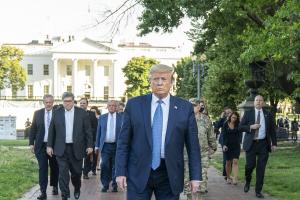
Please, President Trump, do more than grasp that Bible, do more than raise it high. Why not read the thing, and find in its pages a different way to live, a different way to construe reality, a better way to form a community. In that very Bible lies the backdrop of the First Amendment to the Constitution, for the freedom that amendment promises to all was regularly seen in the pages of the Bible where one finds the God of freedom for all people.
(Images from Wikimedia Commons)


